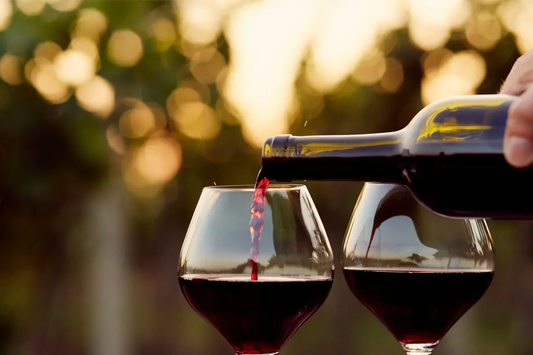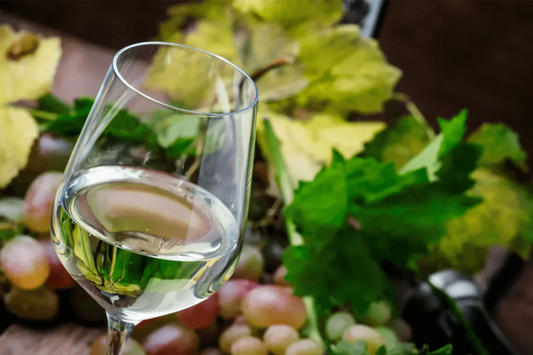
Types of Rosé Wine: Expert Tips for Choosing and Enjoying the Best Bottles
Rosé wine has become one of the most versatile styles in the wine world, appreciated for its refreshing taste, food-friendly qualities, and stunning pink colour. Whether you favour dry, crisp bottles or sweeter, fruitier sips, rosé offers something for every palate. This guide outlines the main types of rosé wine, their flavours, and how to select the perfect bottle for your next occasion.
What is Rosé Wine?
Rosé wine sits between red and white wine in both colour and flavour. It achieves its characteristic blush hues through limited skin contact, where red grape skins remain in the juice just long enough to impart a pink tint and subtle tannins. Unlike a common misconception that it is a blend of red and white wines, rosé is deliberately crafted, resulting in styles ranging from bone-dry and crisp to fruity and semi-sweet. Its balance of freshness and approachability makes rosé one of the best wine choices for both beginners and casual drinkers.
How Rosé Differs from Red and White Wine
| How Rosé Differs from Red and White Wine: A Quick Comparison | |||
|---|---|---|---|
| Feature | Red Wine | Rosé Wine | White Wine |
| Skin Contact | Weeks | 2–20 hours | None or minimal |
| Grape Type | Red grapes | Red grapes | White or red grapes |
| Colour | Deep red to purple | Pale pink to vibrant pink | Pale yellow to golden |
| Tannin Level | High | Light | Very low |
| Flavour Complexity | Bold, structured | Fresh, fruity, nuanced | Crisp, light, refreshing |
Still curious about the classic debate?
🍷 Learn more in our guide to Red Wine vs White Wine: What’s the Difference? – discover how flavour, body, and winemaking truly set them apart.
What is Rosé Wine Made Of?
Rosé wine is often crafted from red grape varieties. Unlike red wine, it spends just a short time in contact with the grape skins, which is what gives rosé its lovely pink colour and lighter flavour profile. The type of grape used, such as Grenache, Syrah, or Pinot Noir, can add unique touches to its taste, but the real star of the show is the way it's made. Let's explore the methods used to create this refreshing wine!
- Maceration: The most common technique, where red grape skins are left in contact with the juice for a brief period.
- Saignée (“Bleeding”): Juice is "bled off" early during red wine fermentation and made into rosé.
- Blending: A small amount of red wine is added to white wine, mainly for sparkling rosé like Champagne.
Types of Rosé Wine
Rosé wine offers a range of styles and flavours, each one showcasing its unique grape variety, winemaking techniques, and the region it hails from. Let’s take a closer look at some of the most popular types of rosé that you can find across the globe.
Provence Rosé
Provence rosé is widely regarded as the benchmark for rosé wines, famous for its pale pink colour, elegant texture, and crisp, dry finish. Made in the sun-drenched vineyards of southern France, this wine is primarily crafted from Grenache, Syrah, and Cinsault. With over 80% of the region’s wine production dedicated to rosé, Provence has established itself as the global leader in pink wine production.
Flavours and Style
Expect delicate notes of red berries, citrus, and fresh herbs, balanced by a light minerality and refreshing acidity. This makes Provence rosé one of the most food-friendly rosé wines.
Best Pairings & Occasions
Serve well-chilled (8-10°C / 46-50°F). It pairs beautifully with seafood, grilled chicken, or Mediterranean salads, and is a favourite choice for summer gatherings, beach picnics, or relaxed evenings outdoors.
🔍 Quick Facts
- Style/Structure: Pale, light-bodied, dry
- Flavours: Red berries, citrus, herbs, floral notes
- Region: Provence, France
- Food Pairings: Seafood, salads, grilled chicken, Mediterranean dishes
White Zinfandel
White Zinfandel is one of the most famous rosé wines in the United States and played a key role in introducing Americans to rosé. Recognised for its lively pink colour and approachable sweetness, this wine is fruit-driven, juicy, and smooth, making it especially popular among beginners or anyone who prefers a sweeter style of rosé.
Flavours and Style
Expect flavours of ripe strawberries, melon, and a touch of sweet spice. With its off-dry to sweet profile and medium body, White Zinfandel is a crowd-pleasing choice that’s easy to enjoy on its own or with food.
Best Pairings & Occasions
Serve chilled (8-10°C / 46-50°F). Its hint of sweetness makes it perfect with spicy dishes like BBQ, Asian cuisine, or Mexican food, as well as strong cheeses that balance the fruitiness. This makes White Zinfandel a go-to for casual gatherings, outdoor picnics, and summer parties.
🔍 Quick Facts
- Style/Structure: Off-dry to sweet, medium-bodied
- Flavours: Strawberry, melon, sweet spice
- Region: California, USA
- Food Pairings: BBQ, spicy food, strong cheeses
Garnacha Rosado
Garnacha Rosado (Grenache Rosé) is a quintessential Spanish wine that highlights the grape’s natural fruitfulness and lively acidity. Mainly produced in Aragon and Navarra, it is usually dry and full of ripe berry flavours, making it one of the most beloved rosé varieties in Spain and beyond.
Flavours and Style
This rosé offers lively notes of strawberry, raspberry, and crisp apple, with a zesty, refreshing finish. Its fruit-forward and dry style makes it versatile and accessible for all wine enthusiasts.
Best Pairings & Occasions
Serve well-chilled (8-10°C / 46-50°F). Garnacha Rosado is a natural match for Spanish tapas, paella, or grilled seafood, and is perfect for alfresco dining and summer celebrations.
🔍 Quick Facts
- Style/Structure: Dry, fruit-forward
- Flavours: Strawberry, raspberry, apple
- Region: Spain (especially Aragon and Navarra)
- Food Pairings: Tapas, paella, grilled seafood
Cinsault Rosé
Cinsault rosé is loved for its refined, easy-drinking style. Originating mainly from southern France but also made in South Africa, this rosé is known for its delicate aromas and refreshing lightness. With low tannins and subtle berry and floral notes, it remains one of the most approachable choices for beginners and casual drinkers alike.
Flavours and Style
Expect flavours of red berries, subtle floral hints, and a touch of spice, all carried on a soft, refreshing finish. Its light body and crisp acidity make it an easy-to-enjoy, versatile rosé.
Best Pairings & Occasions
Serve chilled at 8-10°C (46-50°F). Cinsault rosé pairs beautifully with sushi, summer salads, or light fish dishes, making it a go-to choice for warm-weather dining, picnics, or an aperitif before dinner.
🔍 Quick Facts
- Style/Structure: Light, fresh, low tannin
- Flavours: Red berries, floral notes, subtle spice
- Region: Southern France, South Africa
- Food Pairings: Sushi, light fish dishes, summer salads
Pinot Noir Rosé
Pinot Noir rosé is one of the most sophisticated and food-friendly rosé wines, valued for its crisp acidity and subtle fruit notes. Produced in cooler regions such as Burgundy and Oregon, it offers a lively yet elegant balance, making it a favourite among wine enthusiasts who prefer lighter, dry rosé styles.
Flavours and Style
Expect flavours of strawberry, watermelon, and rose petals with a clean, mineral edge. Its crisp and dry structure makes it an excellent choice for those who prefer a refreshing yet flavourful rosé.
Best Pairings & Occasions
Serve well-chilled at 8-12°C (46-54°F). Pinot Noir rosé pairs gracefully with salmon, goat cheese salads, or tomato-based pasta, making it ideal for alfresco lunches, seafood dinners, or summer gatherings.
🔍 Quick Facts
- Style/Structure: Crisp, delicate, dry
- Flavours: Strawberry, rose petal, watermelon
- Region: France (Burgundy), USA (California, Oregon)
- Food Pairings: Salmon, goat cheese salad, tomato-based pasta
Ready to put your new rosé knowledge into action?
🌸 Check out our roundup of the 8 Best Canned Rosé Wines to Try (2025 Edition) and find your next refreshing favourite.
Mourvèdre Rosé
Mourvèdre rosé, especially from the Bandol region in Provence, is recognised for being one of the most full-bodied and complex rosé wines. Unlike lighter, fruit-driven rosés, this style combines ripe fruit flavours with earthy and savoury notes, providing depth and richness that appeal to more adventurous wine drinkers.
Flavours and Style
Expect flavours of peach, cherry, and ripe red fruit, layered with herbal undertones and a touch of earthiness. With its medium to full body and structured profile, Mourvèdre rosé delivers more weight and complexity than most rosé wines.
Best Pairings & Occasions
Serve at 10-12°C (50-54°F). This style pairs beautifully with grilled meats, Mediterranean lamb, and roasted vegetables, making it ideal for cooler evenings, barbecues, or meals that call for a rosé with substance.
🔍 Quick Facts
- Style/Structure: Medium to full-bodied, complex
- Flavours: Peach, herbs, cherry, earthy notes
- Region: Provence (Bandol), France; Spain
- Food Pairings: Grilled meats, Mediterranean lamb, roasted vegetables
Rosato (Italian Rosé)
Rosato, Italy’s counterpart to rosé, is known for being more robust and flavourful than the lighter French styles. Typically crafted from Sangiovese, Montepulciano, or Barbera grapes, Italian rosato combines juicy red fruit with savoury notes, giving it both freshness and depth. It’s a great choice for those who enjoy rosé with a little more structure.
Flavours and Style
Expect cherry, cranberry, and red plum, often complemented by herbal tones or even a touch of bitter orange peel. Rosato wines range from crisp and fruity to savoury and complex, making them suitable for many occasions.
Best Pairings & Occasions
Serve chilled at 10-12°C (50-54°F). Rosato pairs perfectly with Italian staples like charcuterie, tomato-based pasta, or rustic stews, making it a go-to for both casual dinners and festive gatherings.
🔍 Quick Facts
- Style/Structure: Fruity, savoury, robust
- Flavours: Cherry, cranberry, red plum, bitter orange peel, dried herbs
- Region: Italy (Tuscany, Abruzzo, Puglia)
- Food Pairings: Charcuterie, stews, tomato-based dishes
Pink Prosecco
A newcomer to the sparkling wine scene, Pink Prosecco blends Italy’s cherished Glera grape with Pinot Noir to produce a light, refreshing, and celebratory rosé. With its lively sparkle and subtle fruitiness, it has swiftly become a favourite for brunches, parties, and aperitifs.
Flavours and Style
Pink Prosecco is typically dry and crisp, showcasing flavours of summer berries, apple, and zesty citrus. Its elegant bubbles make it approachable yet stylish, perfect for both casual and festive occasions.
Best Pairings & Occasions
Serve at 6-8°C (43-46°F). Ideal as an aperitif, Pink Prosecco also pairs with appetisers, seafood, and creamy cheeses, making it one of the most food-friendly sparkling rosés.
🔍 Quick Facts
- Style/Structure: Light, sparkling, dry
- Flavours: Summer fruits, apple, citrus
- Region: Veneto, Italy
- Food Pairings: Appetisers, soft cheeses, seafood
Moscato Rosé
Moscato rosé is a sweet and aromatic rosé that’s especially popular among beginners and those who prefer sweet flavours. Made mainly from Muscat grapes, it has low alcohol content, gentle bubbles, and fruity sweetness, making it ideal for dessert pairings or simply as a fun, easy-drinking option.
Flavours and Style
Expect lush notes of strawberry, peach, and orange blossom, balanced with light fizz. Its off-dry style makes it an excellent bridge for those new to wine who want something approachable.
Best Pairings & Occasions
Serve chilled at 6-8°C (43-46°F). Moscato rosé is a delightful match for fruity desserts, spicy Asian dishes, or fresh summer fruit platters, and it’s an excellent option for celebratory toasts.
🔍 Quick Facts
- Style/Structure: Sweet, lightly sparkling
- Flavours: Strawberry, orange blossom, peach
- Region: Italy (Piedmont), USA, Australia
- Food Pairings: Fresh fruit, dessert, spicy Asian cuisine
Rosé Champagne
Rosé Champagne is the pinnacle of sparkling rosé, celebrated for its elegance, delicate bubbles, and opulent depth. Crafted with traditional methods from classic Champagne grapes (Pinot Noir, Pinot Meunier, Chardonnay), it offers a silky texture and complex flavours that distinguish it from other sparkling rosés.
Flavours and Style
Expect red berries, citrus zest, and brioche, often finished with almond or mineral notes. Its dry, crisp structure with creamy mousse makes it an unforgettable experience in every sip.
Best Pairings & Occasions
Serve at 8-10°C (46-50°F). While perfect for special occasions and celebrations, Rosé Champagne also pairs beautifully with oysters, scallops, or caviar, elevating both the dish and the wine.
🔍 Quick Facts
- Style/Structure: Dry, sparkling, creamy
- Flavours: Red berries, brioche, almond
- Region: Champagne, France
- Food Pairings: Oysters, scallops, gourmet appetisers
| Top 10 Types of Rosé Wine | ||||
|---|---|---|---|---|
| Rosé Wine Type | Flavours | Style/Body | Serving Temp | Best Food Pairings |
| Provence Rosé | Red berries, citrus, herbs, floral | Pale, light-bodied, dry | 8-10°C (46-50°F) | Seafood, salads, grilled chicken, Mediterranean dishes |
| White Zinfandel | Strawberry, melon, sweet spice | Off-dry to sweet, medium-bodied | 8-10°C (46-50°F) | BBQ, spicy food, strong cheeses |
| Garnacha Rosado | Strawberry, raspberry, apple | Dry, fruit-forward | 8-10°C (46-50°F) | Tapas, paella, grilled seafood |
| Cinsault Rosé | Red berries, floral, subtle spice | Light, fresh, low tannin | 8-10°C (46-50°F) | Sushi, light fish dishes, summer salads |
| Pinot Noir Rosé | Strawberry, rose petal, watermelon | Crisp, delicate, dry | 8-12°C (46-54°F) | Salmon, goat cheese salad, tomato-based pasta |
| Mourvèdre Rosé | Peach, cherry, earthy herbs | Medium to full-bodied, complex | 10-12°C (50-54°F) | Grilled meats, Mediterranean lamb, roasted vegetables |
| Rosato (Italian Rosé) | Cherry, cranberry, red plum, herbs | Fruity, savoury, robust | 10-12°C (50-54°F) | Charcuterie, tomato pasta, rustic stews |
| Pink Prosecco | Summer fruits, apple, citrus | Light, sparkling, dry | 6-8°C (43-46°F) | Appetisers, seafood, soft cheeses |
| Moscato Rosé | Strawberry, peach, orange blossom | Sweet, lightly sparkling | 6-8°C (43-46°F) | Fresh fruit, desserts, spicy Asian cuisine |
| Rosé Champagne | Red berries, brioche, almond | Dry, sparkling, creamy | 8-10°C (46-50°F) | Oysters, scallops, gourmet appetisers |
Conclusion
Rosé wine is much more than just a pink drink. It's a fantastic category bursting with variety, craftsmanship, and flavour. Whether you like your rosé dry and crisp or sweet and fruity, by exploring the different styles of rosé, you'll see that there is a rosé for everyone.
FAQ
1. What is rosé wine?
Rosé wine is essentially crafted from red grapes, but what sets it apart is the brief time the grape skins are allowed to mingle with the juice. This quick contact is what gives rosé its pink hue, along with a flavour that blends the crispness of white wine and the delicate fruitiness of red wine.
2. How is rosé wine produced?
Rosé wine can be made using one of three popular methods. The first is maceration, where red grape skins are soaked with the juice for a short period. Then, there's the saignée or "bleeding" method, which involves removing some juice early on during red wine fermentation. Lastly, some rosé wines are crafted by blending a splash of red wine into white wine, particularly for sparkling varieties. Each of these techniques influences the wine’s colour and flavour.
3. What is the ideal serving temperature for rosé wine?
When enjoying rosé wine, aim to serve it between 7°C and 13°C (45°F and 55°F). Chilling the wine enhances its crisp and refreshing flavours, as well as its aromatic qualities. This makes it an ideal choice for warm weather and a versatile option for pairing with a variety of dishes at the dinner table.
4. How long does rosé wine last after opening?
After opening a bottle of rosé, it’s best to reseal it and pop it in the fridge. To enjoy the wine at its best, try to finish it within three days. Beyond that, it can start to lose its aromas and that refreshing crispness, so make sure to enjoy it soon after you’ve opened it for the ultimate experience.
Want to learn more about keeping your wine fresh after opening? Check out our complete guide: How Long Does Wine Last Once Opened? for expert tips on wine storage and maximising every bottle!
5. Which types of rosé wine are best?
Choosing the right rosé wine comes down to your taste and the occasion at hand. Many people adore Provence rosé for its dry, elegant character, while those who prefer a sweeter profile might lean towards White Zinfandel or Moscato rosé. If you're celebrating something special, you can't go wrong with a Rosé Champagne.



